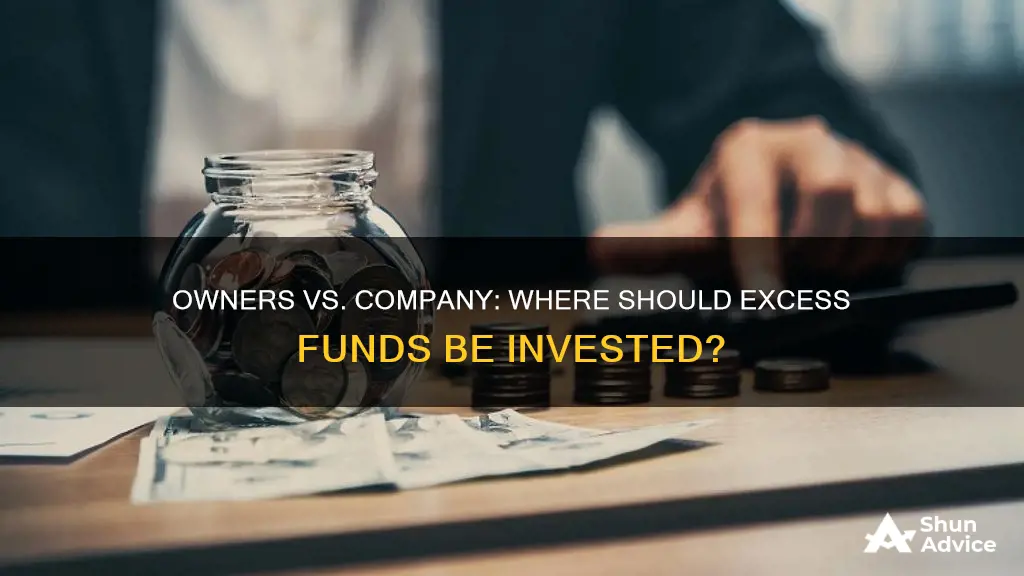
Deciding what to do with excess funds is a challenge many business owners would love to have. While it may be tempting to splash out on a bonus for yourself or your staff, there are many other options to consider. These include paying off debt, investing in the stock market, buying inventory or assets, or simply holding on to the cash. Each of these options has its own advantages and disadvantages, and the best choice for you will depend on your business's unique situation.
| Characteristics | Values |
|---|---|
| Should the owner or company invest excess funds? | This depends on the company's financial situation and goals. Owners can choose to reinvest excess funds into the company or distribute the funds among themselves. |
| Reinvesting into the company | Reinvesting excess funds into the company can help drive optimizations, build systems, and prepare for potential market shocks. This can include establishing cash reserves, eliminating debts, purchasing inventory or assets, or investing in the stock market or other financial instruments. |
| Distributing funds to owners | Owners can choose to distribute excess funds among themselves through dividend distributions, salary payments, loan or lease payments, or guaranteed payments. This can provide a return on their investment and ensure proper compensation for their contributions to the company's success. |
What You'll Learn

Investing in the stock market
Investing excess funds in the stock market can be a powerful way to grow your wealth over time. Here are some key considerations for investing in the stock market:
Understanding the Basics
Stocks are a type of security that gives stockholders a share of ownership in a company. Companies sell shares, usually through an initial public offering (IPO), to gain additional funds for growth. After the IPO, stockholders can buy or sell shares on the stock market. The price of stocks rises or falls due to various factors, such as expectations of the company's earnings or profits.
There are two main types of stocks: common stock and preferred stock. Common stock entitles owners to vote at shareholder meetings and receive dividends. On the other hand, preferred stockholders typically don't have voting rights but receive dividend payments before common stockholders and have priority in the event of bankruptcy.
Types of Stocks
When investing in the stock market, it's essential to understand the different types of stocks available:
- Growth Stocks: These are stocks with earnings growing faster than the market average. Investors buy them for potential capital appreciation, and they rarely pay dividends. Start-up technology companies often fall into this category.
- Income Stocks: Income stocks consistently pay dividends, which are portions of the company's earnings distributed to shareholders. Investors are attracted to these stocks for the income they generate. Established utility companies are commonly considered income stocks.
- Value Stocks: Value stocks have a low price-to-earnings (PE) ratio, making them cheaper to buy compared to stocks with a higher PE ratio. Value stocks may be undervalued by the market, and investors buy them hoping for a rebound in price.
- Blue-Chip Stocks: Blue-chip stocks are shares in large, well-known companies with a solid history of growth and typically pay dividends.
Benefits and Risks of Investing in Stocks
However, there are also risks associated with stock market investments. Share prices can fall, and in extreme cases, a company may go bankrupt, resulting in losses for investors. It's important to remember that the value of your shares will fluctuate, and dividend payments may vary.
Ways to Buy Stocks
There are several common ways to purchase stocks:
- Direct Stock Plans: Some companies allow you to buy or sell their stock directly through them, sometimes with restrictions to employees or existing shareholders.
- Dividend Reinvestment Plans: These plans allow you to reinvest dividend payments to buy more shares of the same stock.
- Brokers: Discount or full-service brokers buy and sell shares for their customers for a commission fee. Many brokers offer websites where you can conveniently purchase stocks.
- Stock Funds: Stock funds, also known as mutual funds, primarily invest in stocks and are offered by investment companies. You can purchase them directly from the investment company or through a broker or adviser.
Research and Due Diligence
Before investing in a stock, it's crucial to conduct thorough research on the company and its performance history. Some sources of information include annual reports, prospectuses (legal documents filed with the U.S. Securities and Exchange Commission), and stock reports provided by brokers or investment advisers.
Additionally, it's important to work with licensed professionals and ensure that the investment products you consider are registered with the relevant financial authorities. Ask questions about the investment and the professionals selling it to assess its legitimacy and potential risks.
Invest in ASX Index Funds: A Comprehensive Guide
You may want to see also

Paying off debt
Understanding the Importance of Paying Off Debt:
Before allocating excess funds, it is essential to recognize the benefits of paying off debt. Firstly, it helps individuals and businesses save money in the long run by reducing the total amount paid in interest. Interest accrues over time, and the longer the debt remains unpaid, the more interest accumulates. By paying off debt, you can avoid this additional cost. Additionally, paying off debt improves an individual's or business's creditworthiness. This can lead to better loan terms and interest rates in the future, making it easier to secure financing for important purchases.
Prioritize High-Interest Debt:
Not all debt is created equal. Focus your attention on high-interest debt, such as credit card balances, which often carry significantly higher interest rates than other types of loans. By targeting these debts first, you can prevent them from growing larger and save yourself from paying excessive interest.
Evaluate the Interest Rate vs. Investment Returns:
When deciding whether to pay off debt or invest, consider the interest rate on your debt and compare it to the potential returns on your investments. If the interest rate on your debt is higher than the expected returns on your investments, it is generally advisable to prioritize paying off the debt. This ensures that you are not losing more money by holding onto the debt.
Create a Comprehensive Plan:
Develop a strategy that outlines how you will allocate your excess funds to pay off debt. Consider the total amount of debt, the interest rates associated with each debt, and the minimum payments required. By understanding these factors, you can create a timeline and plan for eliminating your debt.
Refinancing and Debt Consolidation:
Explore options for refinancing your debt or consolidating multiple debts into a single loan with more favorable terms. Refinancing can reduce your interest rates, lowering the overall cost of the debt. Debt consolidation simplifies your repayment process by combining multiple debts into one, making it easier to manage your finances.
Avoid Using Retirement Funds:
Using funds from retirement accounts, such as 401(k) or IRA, to pay off debt is generally not recommended. Early withdrawals from these accounts often incur penalties and taxes, reducing the amount available for debt repayment. Additionally, these funds are intended for long-term financial security during retirement, and using them for short-term debt repayment can jeopardize your future financial stability.
Consider Selling Non-Retirement Investments:
If you have non-retirement investments, such as stocks, bonds, or cryptocurrencies, consider liquidating them to pay off high-interest debt. However, be mindful of capital gains tax, which can reduce the amount available for debt repayment. Weigh the benefits of selling these investments against the potential returns if held long-term.
Maintain an Emergency Fund:
While paying off debt is important, it is crucial to have a safety net for unexpected expenses. Ensure that you have an emergency fund separate from your debt repayment funds. This will help you avoid taking on additional debt in the event of unforeseen financial challenges.
Seek Professional Advice:
Remember, paying off debt is a journey that requires discipline and commitment. By following these steps and seeking professional advice, you can effectively utilize your excess funds to achieve financial freedom and build a secure future.
Passive Index Funds: A Simple Guide to Getting Started
You may want to see also

Building a cash reserve
After understanding your cash flow, the next step is to set aside a portion of your profits to create a cash buffer or emergency fund. This savings pool will provide a safety net in case of unexpected expenses or revenue declines. The recommended amount to set aside is based on estimating a scenario where revenues fall by 25% and expenses increase by 50%, ensuring you have enough cash to cover these costs for a few months.
Another strategy to build a cash reserve is to consider paying off debts. Reducing debt can lower your company's debt-to-equity ratio and improve your financial stability. However, it is important to note that some companies strategically maintain a certain level of debt, as it can be a cheaper form of financing than equity.
Additionally, you may want to explore investing your excess funds to make your money work harder for you. This could include investing in money markets, which offer high liquidity and low risks, or considering safer long-term investments like bonds. Investing in a diversified stock portfolio is also an option, offering potential annual returns of 5-10%.
Finally, don't forget to reward your staff for their contributions to your success. Allocating a portion of your excess funds towards employee bonuses or contributions to their 401(k) plans can boost morale, show your appreciation, and help retain talent.
Remember, there is no one-size-fits-all approach to cash strategies, and it's important to seek expert financial advice to determine the best course of action for your unique business needs.
Vanguard Funds: Best Bets for New Investors
You may want to see also

Paying dividends to owners
Dividends are an attractive option for investors looking to generate income, and they are also a powerful signal of a company's financial health and future prospects. A company that pays out a dividend attracts investors and creates demand for its stock. A history of consistent dividend payments indicates that a company is financially stable and has a positive outlook.
However, it is important to note that not all companies pay dividends. Some choose to retain their earnings and reinvest them into the company, particularly younger companies in the early stages of development.
There are a few different methods for paying dividends, including the residual dividend policy, the stable dividend policy, and the hybrid approach. The residual dividend policy allows companies to use their retained earnings to invest back into the company before returning funds to shareholders. The stable dividend policy involves paying a consistent dividend each year, regardless of earnings fluctuations. The hybrid approach combines these two methods, offering a set dividend that is a small portion of yearly income, with an additional dividend paid when income exceeds certain benchmarks.
When deciding whether to pay dividends, businesses should consider their financial situation, the impact on investors, and the potential for future growth. Dividends can be a powerful tool for attracting and retaining investors, but they may also limit a company's ability to reinvest in its own growth.
Debt Fund Investment Guide for Indians
You may want to see also

Investing in money markets
Money market funds are a type of mutual fund that invests in short-term debt securities. They are considered extremely low-risk investments due to their focus on low-risk, highly liquid, short-term debt instruments. Money market funds are also highly flexible, allowing investors to buy and sell shares at any time.
Money market funds are an excellent option for those seeking a stable, conservative investment with modest income generation. The funds are mandated to follow guidelines set by financial regulators, such as the U.S. Securities and Exchange Commission (SEC), which help maintain their stability and security. The SEC classifies money market funds into three categories: government, prime, and municipal.
Government money market funds invest primarily in cash and U.S. Treasury securities, providing a lower credit risk and return profile. Prime money funds invest in floating-rate debt and commercial paper of non-Treasury assets, while municipal money market funds offer earnings exempt from federal income tax and, in some cases, state income taxes.
Money market funds are an attractive option for investors who want to avoid the risks associated with stocks and bonds. They are also a good choice for those seeking a temporary parking spot for their money before investing elsewhere or making anticipated cash outlays. However, it is important to note that money market funds are not suitable for long-term investment goals, as they offer limited capital appreciation.
When considering money market funds, it is essential to evaluate the fees and expenses associated with the fund. Additionally, while money market funds are relatively safe, they are not insured by the Federal Deposit Insurance Corporation (FDIC) and are subject to interest rate fluctuations.
A Beginner's Guide to Mutual Fund Investing in Europe
You may want to see also
Frequently asked questions
Holding on to excess funds can provide choices for the future, such as paying down debt, buying inventory, purchasing assets, or paying dividends to owners. It also enables the capture of upside opportunities that may arise.
A persistent and growing reserve typically signals strong company performance. Companies in cyclical industries, like manufacturing, need to stockpile cash to ride out cyclical downturns.
High levels of cash on the balance sheet can indicate that management has run out of investment opportunities or is too short-sighted to know what to do with the money. It can also be a costly luxury, with an opportunity cost that amounts to the difference between the interest earned and the price paid for having the cash.
There are several ways to withdraw excess funds from a business, including distributions of earnings to owners (dividends), payments of salary to owners, payments to owners for loans and leases, guaranteed payments, and sales of accounts receivable.
There are several ways to invest excess funds, including mutual funds, online high-yield savings accounts, a Roth IRA, peer-to-peer lending, and a 401(k) plan. Each option has its own risks and potential returns, so it is important to consider your financial goals and risk tolerance when making a decision.







